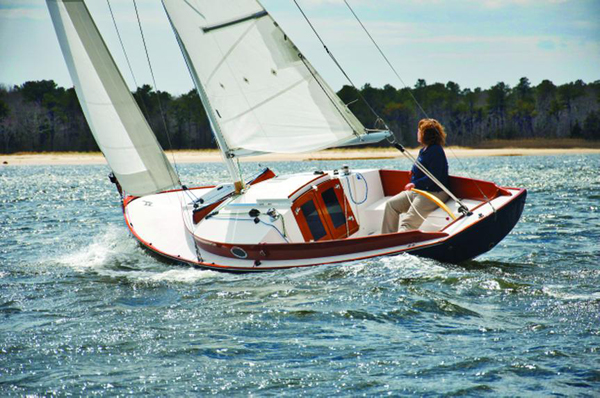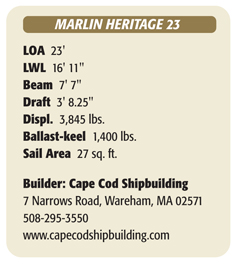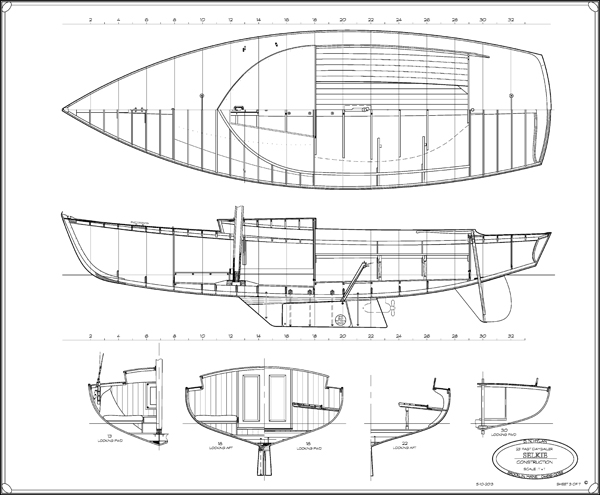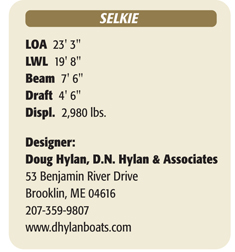 The new Cape Cod Marlin Heritage 23 sports an elongated, roomy cabin as well as
a nice cockpit for daysailing.
Photo by Michael C. Magni, Cape Cod Shipbuilding Co.
The new Cape Cod Marlin Heritage 23 sports an elongated, roomy cabin as well as
a nice cockpit for daysailing.
Photo by Michael C. Magni, Cape Cod Shipbuilding Co.
In a boat this small, having the cockpit floor below the waterline almost inevitably makes seating more comfortable—a key consideration for daysailing.
The Classic Boat Shop in Bernard, Maine, builds a cold-molded or fiberglass variant called the Pisces 21. Although its designer, my twin brother Chuck Paine, tweaked the Wizard’s original in a few ways, the Pisces is still basically a sound, leak-free, Herreshoff Fish. All of Classic Boat’s Pisces-building slots seem to sell out each winter, and for good reason. About the only thing the boats lack is a marine head and a sleeping berth.
Now there are two additional, new, and excellent designs that embellish upon the excellence of the Herreshoff Fish: the Cape Cod Marlin Heritage 23 and the Selkie, a design by Doug Hylan.


Doug Hylan has drawn plans for a 23-foot keel-centerboard sloop that he calls a Selkie. It is deigned to be stable in a steady breeze and hold up to six people in its comfortable cockpit.

In a small boat you can have a big cockpit or a big cabin; usually you can’t have both.
The Selkie’s cabin is just a cuddy, but with a little tweaking, I expect Hylan could design in a head and a berth... at least one.
My only critique of the drawings so far is that the tiller looks to be a little short. With the ability to vary the balance by angling the centerboard, perhaps designer Hylan is one step ahead of me regarding that.
An inboard motor, or at least one which can be instantly employed, is nearly essential for a daysailer. Hylan has specified a German-made electric motor with a folding propellor installed under the hull just aft of the keel. It’s a perfect solution, partly because batteries are so simple to deal with compared with even the best gasoline-powered outboard motors.
This species of Fish lacks a self-bailing cockpit, which means it will require a cockpit tent, an electric bilge pump, or both. Countering that miniscule concern is the factor I call “leg drop.” In a boat this small, having the cockpit floor below the waterline almost inevitably makes seating more comfortable—don’t forget the importance of comfort as a key consideration for daysailing.
Another reason to recommend the Selkie design is the reputation and proven past accomplishments of Hylan. Previously, he’s mostly designed and built powerboats and small craft. When the first Selkie is launched from a trailer, I am confident it will prove a thing of beauty as well as a versatile and sprightly performer.
Contributing Author Art Paine is a boat designer, fine artist, freelance writer, aesthete, and photographer who lives in Bernard, Maine.Magazine Issue #
Display Title
Near-perfection, Improved: the Marlin Heritage 23 and the Selkie
Secondary Title Text
Two classic daysailers based on the Herreshoff Fish Class
Sections






